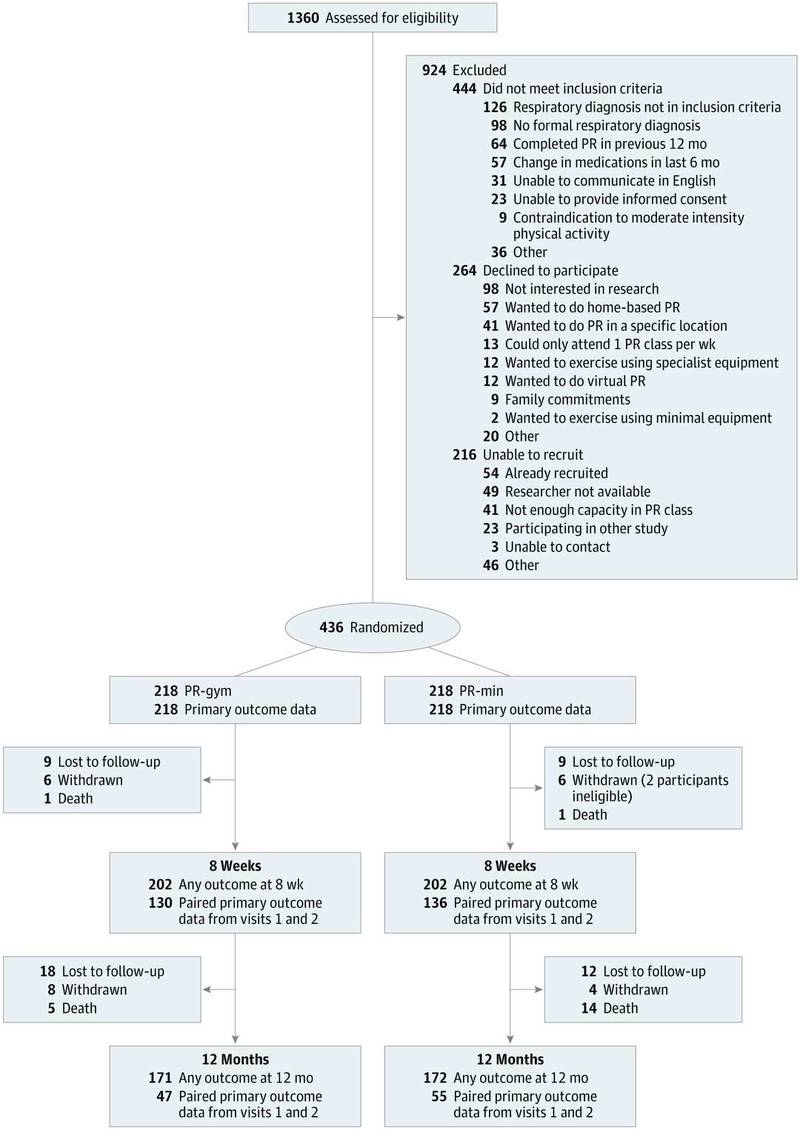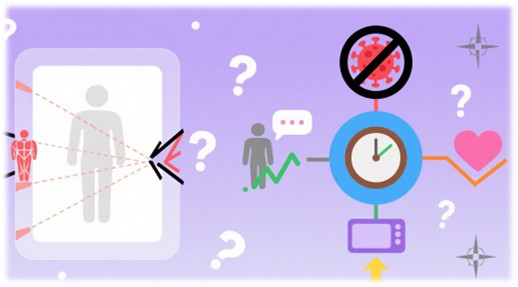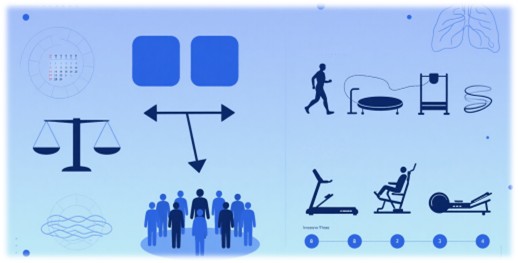Pulmonary rehabilitation (PR) stands as a cornerstone in the management of chronic respiratory conditions, offering a multidisciplinary approach that integrates exercise training, education, and self-management strategies to enhance patients' physical capacity and quality of life. Traditionally, PR has relied heavily on specialized gym-based equipment, such as treadmills, cycle ergometers, and resistance machines, to deliver structured and progressive exercise programs. However, the accessibility and scalability of PR services have been significantly limited by the high costs and infrastructure requirements associated with such specialized equipment. Against this backdrop, the study published in JAMA Network Open emerges as a pivotal investigation, challenging the conventional reliance on specialized equipment by demonstrating the noninferiority of PR delivered with minimal equipment (PR-min) compared to traditional PR using specialized gym equipment (PR-gym). This study not only addresses a critical gap in the literature but also holds the potential to transform the landscape of PR delivery, making it more accessible and adaptable to diverse settings.
 Fig.1 Consolidated standards of reporting trials flowchart. (Nolan. C. M., et al., 2025)
Fig.1 Consolidated standards of reporting trials flowchart. (Nolan. C. M., et al., 2025)
Study Design and Methodology: A Rigorous Approach to Assessing Noninferiority

The study was meticulously designed as a parallel, two-group, noninferiority randomized clinical trial, ensuring a high level of scientific rigor and validity. Conducted at the Regional Pulmonary Rehabilitation Unit in northwest London, UK, the study recruited 436 participants with chronic respiratory diseases, reflecting a diverse patient population with a median age of 71.7 years. The randomization process, facilitated by an independent web-based system using minimization with a 1:1 allocation ratio, balanced key factors such as previous PR completion, multiple deprivation index, and physical frailty, thereby minimizing potential biases and enhancing the generalizability of the findings.
Both intervention groups underwent an eight-week outpatient program comprising two supervised sessions per week. The PR-min group utilized minimal equipment, including walking circuits, body weight exercises, portable pedals, and elastic resistance bands, while the PR-gym group engaged with traditional specialized gym equipment. The primary outcome measure, the change in incremental shuttle walk (ISW) distance after the intervention, was selected based on its well-established validity and responsiveness in assessing exercise capacity in respiratory patients. A predefined noninferiority margin of -24 meters was set to determine whether PR-min could achieve comparable improvements in exercise capacity to PR-gym.
Primary Outcome: Exercise Capacity and Noninferiority
The study's primary analysis focused on the change in ISW distance, a critical indicator of exercise tolerance and functional capacity in patients with chronic respiratory conditions. The results revealed significant improvements in ISW distance for both PR-min and PR-gym groups, with no significant difference between the groups (mean difference 1.7 meters; 1-sided 97.5% CI lower bound, -16.8 meters). This finding firmly establishes the noninferiority of PR-min to PR-gym, as the observed difference fell well within the predefined -24-meter noninferiority margin. The consistency of this result across intention-to-treat, per-protocol, and complier-average causal effect (CACE) analyses further strengthens the robustness of the conclusion.
Secondary Outcomes: Dyspnea, Quality of Life, and Beyond
Beyond exercise capacity, the study also assessed secondary outcomes, including dyspnea and health-related quality of life, using the Chronic Respiratory Questionnaire (CRQ). The CRQ, a validated tool for evaluating respiratory symptoms and functional status, comprises multiple domains such as dyspnea, fatigue, emotion, and mastery. The findings indicated that PR-min was noninferior to PR-gym for all CRQ domains, with no significant differences observed between the groups. This comprehensive assessment underscores the holistic benefits of PR-min, demonstrating its capacity to improve not only physical function but also subjective experiences of breathlessness and overall quality of life.
Economic and Safety Considerations: Cost-Effectiveness and Adverse Events

In addition to clinical outcomes, the study evaluated the economic implications and safety profile of PR-min compared to PR-gym. From a cost perspective, PR-min was associated with lower costs (mean difference -£218; 95% CI, -£1640 to £1205) at the eight-week follow-up, although this difference was accompanied by a high level of uncertainty. This cost analysis suggests that PR-min could be a more economically viable option, particularly for settings with limited resources. Regarding safety, the number of adverse events and serious adverse events was comparable between the two groups, with no significant differences in hospitalizations or intervention-related events. These findings indicate that PR-min is not only effective but also safe, without compromising patient safety or introducing additional risks.
Expanding Access to Pulmonary Rehabilitation: Implications for Practice and Policy

The study's findings hold significant implications for the delivery of PR services, highlighting the potential for PR-min to expand access to pulmonary rehabilitation. By demonstrating noninferiority to traditional PR-gym, PR-min offers a flexible and adaptable alternative that can be implemented in a variety of settings, including nonmedical facilities and patients' homes. This flexibility is particularly pertinent in addressing the global shortage of PR services, which is partly attributable to the limited availability of specialized gym equipment and infrastructure. The study's results suggest that PR-min could serve as a viable solution, making PR more accessible to a broader population and potentially improving patient outcomes on a larger scale.
Limitations and Future Directions: Addressing Remaining Questions

Despite its robust design and compelling findings, the study acknowledges several limitations that warrant consideration in future research. The COVID-19 pandemic imposed substantial restrictions on recruitment and face-to-face assessments, contributing to missing data, particularly for outcomes requiring in-person supervision. Additionally, the study did not demonstrate noninferiority for all secondary outcomes, such as isometric quadriceps strength (QMVC), suggesting that PR-min might not provide sufficient resistance training stimulus without specialized equipment. Future research should explore patient preferences for different PR models and investigate the long-term effects of PR-min on higher-functioning individuals. Qualitative studies could also provide valuable insights into patient experiences and satisfaction with PR-min, further informing the development and implementation of PR programs.
Conclusion: A New Era for Pulmonary Rehabilitation
The study published in JAMA Network Open represents a landmark investigation in the field of pulmonary rehabilitation, providing robust evidence that PR using minimal equipment is noninferior to traditional PR using specialized gym equipment. This finding opens the door for more flexible and accessible PR programs, potentially improving the lives of millions of individuals with chronic respiratory conditions. As healthcare providers and policymakers seek to expand access to essential services, PR-min offers a promising solution that is both cost-effective and adaptable to various settings. The study's results underscore the potential for PR-min to become a standard option in pulmonary rehabilitation, offering a more accessible and scalable alternative without compromising on efficacy. Future research and policy initiatives should build on these findings to further optimize PR delivery and enhance patient outcomes in the management of chronic respiratory diseases.
If you have related needs, please feel free to contact us for more information or product support.
Reference
- Nolan, Claire M., et al. "Minimal vs specialized exercise equipment for pulmonary rehabilitation: a randomized clinical trial." JAMA Network Open 8.8 (2025): e2526616-e2526616.
These products and services are for research use only and cannot be used for any clinical purposes!



 Fig.1 Consolidated standards of reporting trials flowchart. (Nolan. C. M., et al., 2025)
Fig.1 Consolidated standards of reporting trials flowchart. (Nolan. C. M., et al., 2025)


